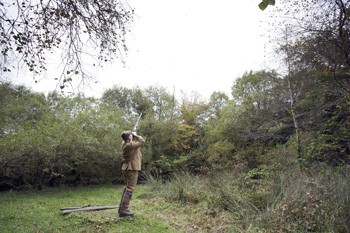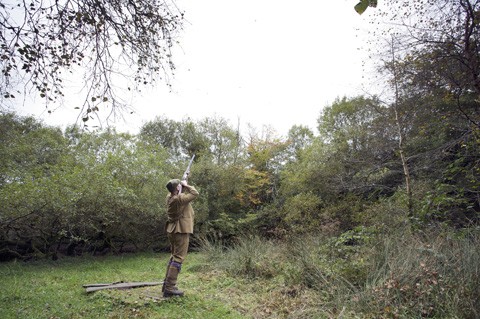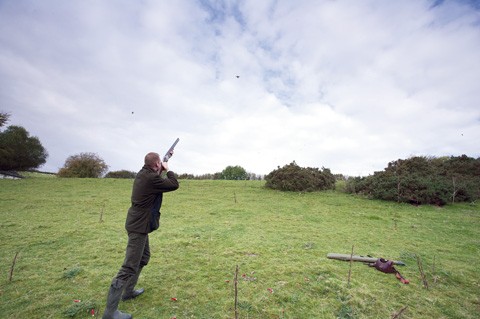Win CENS ProFlex DX5 earplugs worth £1,149 – enter here
Game shooting in Liscombe, Devon
Game shooting in Liscombe, Devon: Ben Samuelson travels to Devon to join a group of City guns on a game shoot steeped in history and sporting excellence.

Game shooting benefits hugely from days booked by guns from the City of London.
Sadly the vast majority of us don’t get the opportunity to see what these days are like, so when an invitation came from Meyrick Cox, a friend who works in mergers and acquisitions, for a day’s shooting at Liscombe my reply was swift.
As someone who is fortunate enough to enjoy most of his sport on family shoots and small syndicates, it is easy for me to form all sorts of preconceptions about these types of days.
These were blown away comprehensively over the 24 hours that I was Meyrick’s guest.
The shoot is in Exmoor and as such is a long drive from pretty much anywhere, but dinner at the Cox family home more than made up for hours in the car.
As Meyrick has a weakness for fast cars and high pheasants, the team of guns wasn’t just made up of his chums from the City.
There were also a couple of motor enthusiasts in the line, including Richard Meaden, one of the UK’s leading motoring journalists.
The following morning, notice was given that this wasn’t going to be a normal day’s shooting, Meyrick leading the convoy across country from his home to Liscombe in an elderly Mercedes G-Wagen.
It might have been painted white some time in the distant past, probably just before it was ‘borrowed’ from one of Medecins Sans Frontiers outposts.
Driving across the southern edge of Exmoor, my fellow guns were abandoning their Blackberries and starting to admire the stunning scenery, obviously wondering what sort of pheasants would be presented over the steep-sided wooded valleys.

Arrival at Liscombe brought a warm welcome from Keith Wade, who has created the Liscombe shoot virtually from scratch.
Keith is someone for whom being a Cornishman is more a definition than just an accident of birth, having only moved up to Liscombe 12 years ago when he bought the valley for the farming.
Even though running the shoot has now become a large part of what Keith does, he still keeps Swaledales and Angus/Limousin-cross suckler cows.
The fact that he has such hardy beasts on such southern land tells you something about what sort of terrain we were going to shoot over.
The ribbing about each gun’s ability was already passing back and forth as we headed out to the first drive, enough to make you realise that any indiscretions were going to be mercilessly punished.
The feeling of pressure rose further as we headed out to the first drive, Varle Hill, as the professional-looking team of pickers-up had lined up at the gateway, inspecting us as we ambled across to our pegs.
Were they deciding who was going to be worth standing behind?
As Meyrick unpacked his .410, the tool of the seriously confident on a day like this, I was fully expecting to find a battalion of pickers-up behind him and an empty field behind me.
Varle Hill is a good example of what is so right about these sorts of days. The birds are driven off the top of a wooded hill, flying across to another wooded hill behind the guns lining up at the bottom of the valley.
As is inevitable when your fellow guns know you’re writing about the day, the first bird to fly towards the guns flew straight and true, clearly target-locked on a spot 70 feet above my head.
What is obviously an extremely disciplined team of beaters were bringing the birds in off the common into both sides of a game crop, before a top line very slowly drove the birds forward.
This meant that, as soon as everyone had watched the first bird head straight for me, the rest of the drive came out in a beautifully steady stream thereafter.
Interspersed among the pheasants was the odd good redleg, especially early on, which, as seems the norm on days like this, the guns all favoured.
More due to the terrain than to any wind, the birds flew slightly diagonally, such that we all had to be careful not to shoot our neighbours’ birds before they’d had a chance to.
It was easy to leave a 50/50 bird, sure in the knowledge that another one just as good would be along soon afterwards.
A short drive took us to the signature drive of the shoot, one that defines it in the memory of everyone that has been fortunate enough to shoot it.
Tarr Steps, a renowned beauty spot where the Little River and the Barle meet is at the heart of the shoot itself.

The drives are set amongst some beautiful landscape.
Guest guns often stay at the Tarr Farm Pub and Hotel nearby, and during the summer there are always a lot of walkers.
Fortunately, the footpaths don’t seem to be too near to the release pens and a combination of judicious path closures and winter weekdays means that having brown signs leading ramblers in the shoot’s direction doesn’t seem to have any negative effect at all.
It merely provides a few people to greet politely on behalf of our sport.
A lot of birds came over us all during the next 20 minutes or so.
Even with a .410 Meyrick was folding up these highest of high West Country birds with his normal elegantly economical shooting style.
Thankfully, immediately afterwards, we had a chance to attend to sore hands, empty cartridge bags and dry throats with a quick trip back to the shooting lodge.
War stories swapped and too many sausages eaten long before lunch it was time to head out to Higher Spire, where the guns stand behind and below a tolerant neighbour’s house.
Lined up along a stream, the guns have to contend with a number of extra hazards, including a brace of alpacas, which don’t seem to be in the slightest bit gun shy, but which do act as a serious disincentive for the dogs that have to go for birds near them.
Here, the open common is behind the guns so the longer retrieves can be watched over the full distance.
Ben Kent, who was picking-up behind me, lets 100 acres of shooting rights to Liscombe and is a regular member of the team.
“It’s exhausting walking up and down Exmoor all day, but Keith is a great host and we are looked after here. It’s worth coming for the food alone.”
Ben’s wife works with a truly excellent dog – a labradinger, the offspring of a standard poodle and a labrador/springer cross, which seems to combine the best qualities of each breed.
It was then off to the final drive of the day, Ashway Side, where the guns lined up along the Little River again and where the birds were driven off a game crop at the edge of the common.
My neighbours were out of sight as the woods are pretty thick and there were still enough leaves on the trees to block the sight, if not the sound of them.
As the carefully choreographed work of the beaters panned out, the guns got busier in succession along the line until it was my turn.
Here again, the birds swoop off the top of the valley side and barrel across towards their release pens on the hillside behind us.
Although many of them split in front of me, due to a clump of trees up the hill, those that came my way were skyscrapers, the like I was pleased I didn’t have to deal with at the very beginning of the day.
On the way back to the lodge, conversation with Keith and his headkeeper Oliver Sanders turned to Liscombe’s future.
What effect had the financial meltdown in the City of London had on the shoot? Keith was typically straight:
“It’s not necessarily all a bad thing. Although our record bag is 560, we really concentrate on 200-250 bird days, which are a lot more fun.”
I can concur with this statement as our bag on this day was 231.
“We aren’t seeing as many corporate days as we were, but the chaps from the City, like Meyrick, are coming back with their friends. I’d rather not do the big days, but could maybe put a third day a week on for big days if the demand is there.”
If the day of towering pheasants, beautifully presented in stunning scenery and some weapons-grade humour is anything to go by, it deserves to be.
Bringing up a shoot in hunting country
“There hasn’t traditionally been a shoot at Liscombe because this has always been, and indeed still is, hunting country,” explained Keith Wade. “It was owned by the Ministry of Agriculture as an experimental farm and it hadn’t been properly shot over in living memory. The year after we bought it, we put a few birds down so we could have a walkabout with some friends. The following year, we had a phone call from a hotel, who had a team of guns coming to stay whose shooting had been double-booked. I got talked into looking after their guests and it all went from there.” Headkeeper Oliver Sanders, who worked at Chargot for four years, and at Lyneham for two before coming to Liscombe three years ago, sums it up best: “Once you’ve got Exmoor in your system you’ll never get it out and this is a great place to work.
Top drive: Tarr Steps
The birds are driven off a game cover, made up of chicory, kale and maize. Keith told me that the maize hasn’t done too well recently as it’s been too cold and wet over the last few summers for it to grow properly. That said, as a steady stream of birds flew out of a game crop some 300 feet above the guns lined up along the Little River, I didn’t see too much of a problem. The beaters on the left stood still and tapped while the top line slowly came half way through the cover before the right hand team steadily advanced the whole way through. Although there wasn’t a breath of wind down in the valley bottom, at the altitude the birds were flying, they seemed to be enjoying the benefits of the jet stream as they rocketed towards us.
Vittles
It’s always a good sign if beaters, pickers-up and guns all eat together and Liscombe is no exception. Although many of the guns had not been there before, all were made very welcome, and were all fed on the same extremely good food. Linda Pugsley and Sharon Vigars make sure that they start with the best local ingredients, as they explained: “Our roast pork and lamb are both from the farm; even the sausages are and we make sure that everyone gets plenty. We also find that it’s almost impossible to cook too many nice crispy roast potatoes. No matter how many we cook, they all seem to go.”
Days at Liscombe can be booked directly with Keith Wade, who charges £35 per bird for bags under 200 and £33 for over 200. For more information contact 01643 851551 or email info@liscombefarm.co.uk
Related Articles
Get the latest news delivered direct to your door
Subscribe to Shooting Times & Country
Discover the ultimate companion for field sports enthusiasts with Shooting Times & Country Magazine, the UK’s leading weekly publication that has been at the forefront of shooting culture since 1882. Subscribers gain access to expert tips, comprehensive gear reviews, seasonal advice and a vibrant community of like-minded shooters.
Save on shop price when you subscribe with weekly issues featuring in-depth articles on gundog training, exclusive member offers and access to the digital back issue library. A Shooting Times & Country subscription is more than a magazine, don’t just read about the countryside; immerse yourself in its most authoritative and engaging publication.







